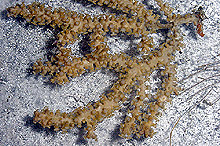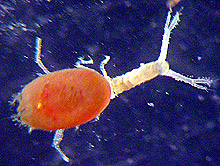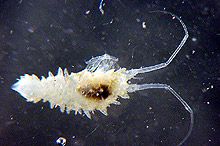
Attached to the sea floor by its holdfast (top right), this soft coral provides a number of hiding places for benthic invertebrates. Click image for larger view.
The Cryptic Life of Benthic Crustaceans
August 11, 2003
Jerry McLelland
Department of Coastal Sciences
University of Southern Mississippi
The weather hasn’t been our friend recently. Since our first day of operations on August 3, we have only been able to accomplish 50% of our planned submersible operations. Instead of 16 dives, two per day, between August 3 and August 10, the sub has only been launched 8 times. With lightning storms clearly visible just before sunrise, it looked like we would have to scratch yet another day of submersible ops. Fortunately, the lightning turned out to be just a beautiful way to begin Monday morning. Dive supervisor Craig Caddigan kept a close eye on the sea and within a few hours of the storm, the waves subsided enough for launch. We hope that the two dives today will be the start of a strong finish to the expedition. Regardless of the number of dives we complete over the next few days, the Charleston Bump has not disappointed in regards to invertebrate life.
Small and fragile benthic organisms, like those found in the Charleston Bump live-bottom habitat, must adopt a cryptic lifestyle (the ability to hide) to survive in a community populated by larger creatures seeking a meal. Hiding places might include crevices between rocks or coral rubble, burrows or tubes among rubble or within soft substrate, lodging within other larger organisms such as sponges or tunicates, or a camouflaged existence among sessile (attached) organisms of the community.
The majority of small mobile crustaceans, such as isopods, amphipods, and tanaids, are deposit feeders, subsisting on leftover energy locked in detritus that drifts to the bottom from the more productive upper water levels. Some ingest unused organic material that passes through the bodies of other animals yet still contains considerable amounts of energy, especially after it has been enriched by attached bacteria. In this way, these tiny, deposit-feeding animals are important to the recycling of nutrients that would otherwise be lost to the sediments.
Some adaptations to cryptic life include being small in size, constructing tubes for concealment and brooding of young, living commensally (on or in larger sessile organisms), burrowing into the upper layers of soft sediment, or merely standing motionless, hoping that specialized appendages and coloration will provide camouflage.

Cumaceans, also called lollipop shrimp, burrow themselves almost completely in the sediment. The only body parts that remain above the surface are their eyes. Click image for larger view.
Being small in size can have its advantages, not only in easier concealment within crevices, but in more efficient utilization of food particles, which are usually limited in deep-water environments.
Small crustaceans that live in tubes not only have a place for concealment, but in some cases have a safe haven for raising their developing offspring. Amphipods, tanaids, isopods, and mysid shrimp belong to the superorder Peracarida, all of which have brood pouches at the bases of their walking legs. Within these pouches, fertilized eggs develop into miniature adults, forgoing the complicated planktonic larval stages of most other crustaceans, such as shrimps, crabs and barnacles, which spew forth millions of eggs into the water in hopes that just a few will survive until adulthood.
Tube-dwelling crustaceans differ from their closely related, more motile cousins by having smooth, thinner, more steamlined carapaces (shells) that are less ornamented. Some have glands on their appendages that secrete tube material from which they construct their simple homes. Tube life is not without its drawbacks, however. Being confined to a tube means that one cannot forage very far in search of food; nourishment is usually limited to detritus that can be gathered in the immediate vicinity of home. Also, the opportunity to find mates is limited. In some species of tanaids, the females stay home in the tube while the larger, more mobile males roam around seeking mates, meanwhile risking the danger of being scarfed down by a hungry damsel fish or other predator. The means of dispersion to new territories for some of these tube-dwelling species is largely unknown.

Isopods are an order of crustaceans closely related to pillbugs. Also members of the superorder Peracarida, they have brood pouches at the bases of their walking legs in which fertilized eggs develop into miniature adults. Click image for larger view.
One particularly strange means of cryptic concealment is seen in the group of amphipods known as caprellids, or skeleton shrimp. These bizarre, stick-like crustaceans are adept at remaining perfectly motionless while clinging to hydroid stalks, sponge spicules and other branch-like growth, where they wait to ambush small, unsuspecting worms, protozoans, and other small creatures. They are provided with grasping claws on their extremely long appendages, by which they are able to climb about like monkeys among the fronds and stems of hydroids, bryozoan colonies and other affordable habitat. Their fore limbs, called gnathopods, are held erect in the manner of a praying mantis to rapidly seize their prey. To the average browsing predator, the caprellid seems to be an ordinary piece of inedible detritus.
The most commonly occurring cryptic crustaceans among the “live rock” encrusting communities of the Charleston Bump are the isopods of the group known as Asellotes, which forage for food particles among the coral and hydroid stalks. They pick through detritus that has settled to the bottom from production sources above, consuming bits of algae, protozoans, and other smaller organisms attracted to the detritus. They can also make use of bacterial-enriched leftovers and waste materials from other organisms in the community. When not feeding, they seek shelter from predators in the crevices among rocks, dead coral, and similar hiding places.

Jerry McLelland, the author of this log entry, spent many hours hunkered over his microscope taking photographs of both benthic and pelagic invertebrates. Click image for larger view.
In investigating the kinds of small crustaceans and other cryptic fauna present in live rock, scientists are able to extract specimens by briefly dipping the live rock into a weak solution of sea water and formalin, causing the animals to rapidly vacate their hiding places. Water containing the animals can then be strained through a fine mesh screen from which the specimens are removed for study. These investigations of cryptic fauna are important in understanding how these small animals help fill in a piece of the puzzle when viewing the overall ecology of hard-substrate communities of the Charleston Bump.
























